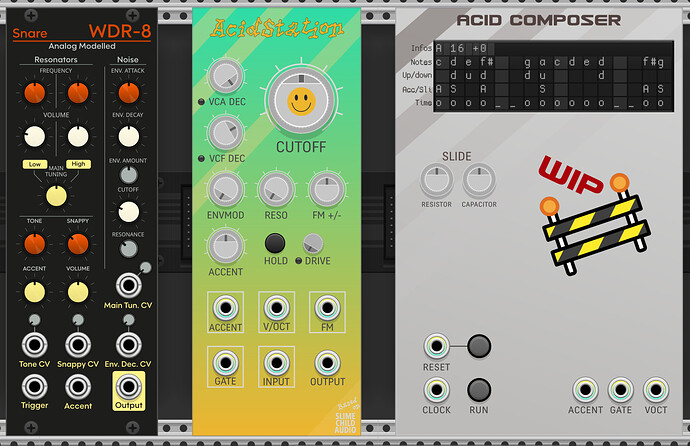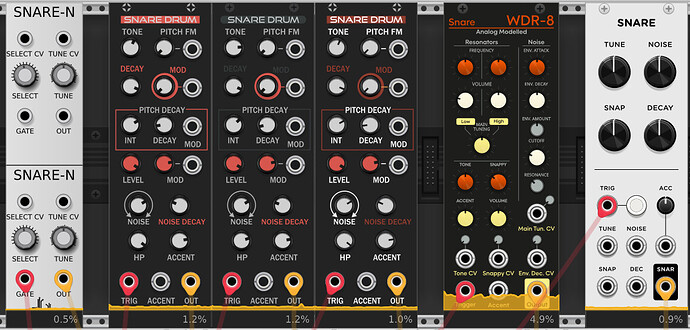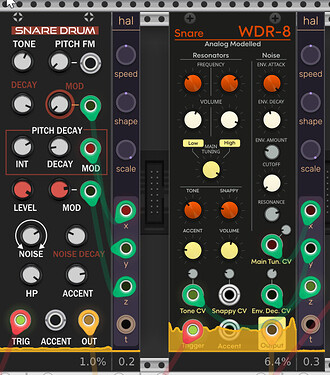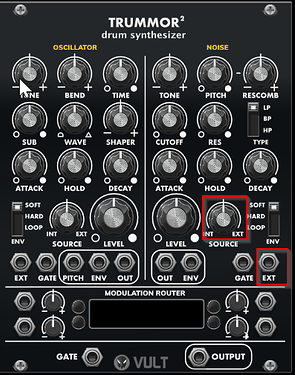Hello hello!
I’m here to announce the immediate availability of beta builds for 3 new modules! This very acid digression is what distracted me from my other module projects…
WDR-8 is a plugin with only one module for now. TAK contains AcidStation and Acid Composer.
From left to right we have:
WDR-8 Snare: Roland TR-808 snare emulation, as faithful as possible yet tuning and envelope controls allow different snare and percussive sounds. WDR stands for “Wave Digital Rhythm”, a nod to the original machine (Transistor Rhythm) and Wave Digital Filters (WDF), which is a modular circuit modelling method, used in this module (and several upcoming others!) to recreate some parts of the electronics found in these machines.
Features:
- Drum shell “resonators” with adjustable frequency and volume, main tuning affecting both
- Noise path going into an “analog” envelope with direct control over discrete components values, affecting attack and decay. High-pass filter with cutoff and resonance controls.
- Tone (resonators mix) and Snappy (noise level), Accent level and volume are original knobs
- CV inputs with modulation attenuators for Tone, Snappy, noise envelope decay and resonators main tuning
The TR-808 Snare has been obsessing me for more than a year and I wasn’t satisfied with the current options in the library. A lot of time went into reading and trying to understand the schematics, then simulate it using engineering tools and finally figuring out how to emulate it using WDF. Actually, recent developments in the WDF library used are used literally as-is for the resonators.
Have fun and let me know if you have any suggestion, comment or questions!
![]() Get the beta here!
Get the beta here! ![]() There is no output clamping, be careful if you crank both accent and volume up!
There is no output clamping, be careful if you crank both accent and volume up!
TAK AcidStation: Around the same time as the 808, Roland released yet another machine that became as much if not more influential, up to this day: the TB-303 Bassline synthesizer. The 303 featured a transistor ladder filter borrowed from common synth designs at the time (more precisely Moog iirc) paired with a relatively basic saw or pulse oscillator. The rest is history that some here likely have witnessed first hand while I was way too young at that time.
AcidStation is an envelope generator, a filter and a VCA stitched together. The envelope and filter are from Substation opensource. Good care was taken to reproduce the VCA and VCF envelopes faithfully in terms of shape and timing. The VCA decay’s default value is what it is normally fixed at. The ranges of the VCF decay, the filter cutoff and resonance are broader than on a 303, allowing more variations. Try it with a short VCA decay!
The Hold button mimics a popular mod on the 303 that enabled infinite sustain, yay! Drive is a nice bonus, also courtesy of Substation’s Saturating mixer.
Link below. ![]()
TAK Acid Composer: After working on the filter and envelopes, it became clear that there was more to the sound of aciiiid than just the right ladder. As I found out, the sequencer plays a big part in selling the distinctive sound of the 303, through specific behaviours regarding gate, notes with slide and/or accent and tied notes. Acid Composer is experimental and unfinished but has proven an interesting experiment so far. I can safely say that a good mix of slides, accents, ties and octave up or down may eventually matter more than a catchy note sequence. That’s right, type in random stuff and adjust until it sounds ok.
Each line of the display at the top contains informations that are parsed into a pattern:
- Infos: letter identifier, length (
 BROKEN) and transpose, eg. +2 is 2 semitones up
BROKEN) and transpose, eg. +2 is 2 semitones up - Notes: note letters from a to g, 2 letters per step, second letter is either # (sharp) or b (flat)
- Up/Down: either u/U for one octave up, d/D one octave down or space for normal octave
- Acc/Sli: either a/A for accented note, s/S for a slid note
- Time: o is play a note, _ is tie, space is no note
As a bonus, TAK includes 2 wavetables made from simulation of the TB-303 oscillators. Namely, the pulse features very unique PWM that is frequency-dependent. Both are 2048 points.
Not very practical (yet) but patterns can be shared like this, copy/paste line by line:
c bbg c#c#c c c d ebf g eb dbb
d ud ddd u
A S A A S A A A A A
ooooooooooooo_oo
Oh, and go grab Substation now!



